
Hip replacement surgery
This information is designed to provide you, your family and your friends with information about your hip replacement and what to expect before and during your stay in hospital.
This advice will help you prepare for surgery and your recovery.
Understanding arthritis and hip replacement
Joint deterioration can affect every aspect of a person’s life. It is common for people to ignore the symptoms of osteoarthritis in its early stages, but as the disease progresses, activities like walking, driving and standing become challenging, painful and very difficult.
Hip replacement surgery is usually an extremely successful surgical procedure. The first total hip replacement surgery was performed over 40 years ago and since then millions of people have received hip replacements. Hip replacement surgery has become a fairly common procedure.
Osteoarthritis
Osteoarthritis (OA) is the most common form of arthritis, and is the most common reason for joint replacement surgery. Osteoarthritis is a degenerative condition that affects the joint cartilage, often leading to painful bone-on-bone contact.
It can cause pain, stiffness, swelling and loss of motion in the joint, which may vary in duration and severity from person to person. Treatments such as the relief of pain, physiotherapy exercise, and weight reduction can help control the symptoms of osteoarthritis for a time. When these treatments fail to provide adequate relief from pain a total joint replacement may be recommended.
Your surgeon will have assessed your individual condition and prescribed a treatment that will give you the best results.
Total Hip Replacement

Total hip replacement surgery or arthroplasty uses implants to resurface and replace the bones in the joint, re-creating the smooth gliding surfaces that were once damaged. Total hip replacement surgery requires anaesthesia. There are various types of anaesthesia available and your anaesthetist will explain your options to you before surgery.
In total hip surgery, an incision is made on the side of the hip muscles to gain access to the joint. The exact site of this incision may vary between surgeons as there are a number of different ways to approach the hip.
The affected portion of the “ball”, or head of the femur (thigh), is removed to allow for the replacement hip component. This is made of a biocompatible (body friendly) metal alloy such as cobalt chrome, stainless steel or titanium.
The “socket” or acetabulum is then shaped to accept the new socket that is pressed into place. There are several materials that can be used to line the socket in your pelvis, including polyethylene (plastic) or ceramic.
There are many types of hip replacements on the market in the UK. The type of hip replacement used may vary from patient to patient for a variety of reasons and your surgeon will discuss this with you.
Your surgery will last approximately one and a half to two hours. Care before your surgery and time spent in the recovery room can add an additional two to three hours before you are back in your hospital room.
What can you expect from a total hip replacement?
A total hip replacement will provide relief from hip pain in over 90 per cent of patients. It will allow patients to carry out normal activities of daily living.
The artificial hip may or may not allow you to return to active sports or heavy labour and you must be guided by your Consultant.
Taking part in high impact activities and being overweight may speed up the wear and tear process, which could result in the artificial hip to loosen and become painful.
Complications
While rare, complications can occur during and after surgery. The risk of something going wrong is approximately four to five per cent . Although implant surgery is extremely successful in most cases, some patients still experience pain and stiffness.
Most patients, however, feel that the relief from the arthritic pain is so good that a certain amount of stiffness does not bother them. No implant will last forever and factors such as your post-surgical activities and weight can affect longevity of the implant. Be sure to discuss all of the risks with your surgeon so that you can minimise the potential for complications. Your surgeon may ask you to see a medical doctor before surgery to obtain tests. You may also need to have your dental work up to date.
Wound infection (0.5%-1%)
The wound on your hip can become inflamed, painful and weep fluid, which may be caused by infection. The majority of wound infections can be treated by a course of antibiotics and often settle down following treatment. Deep wound infection where the new hip is infected may require the new hip to be removed which can result in a leg length shortening. Treatment of infection normally requires one or two more operations. Infection can affect the hip at any time, indeed most are late infections from another side for example, urine or chest.
You can help prevent infections in the wound firstly, by ensuring you are thoroughly showered and clean prior to your surgery. After your surgery you must keep the incision area clean and dry. The wound dressing should normally not be disturbed, and should only be redressed by your nurse. In the long term, you should check with your doctor and dentist prior to any dental treatment or skin or urine infection, as you may need antibiotics. The risk of developing an infection following a hip replacement is one to two per cent. If you have any infections at time of admission for your surgery, please contact your Consultants secretary.
Methicillin Resistant Staphylococcus Aureus (MRSA)
Micro-organisms (germs, bacteria) are all around us but the only way we can see them is with a microscope. We all carry millions of them both on the inside and outside of our bodies. They generally do us no harm at all – in fact most bacterium protects us from infections, but some can cause infections. One of these bacteria is called Staphylococcus Aureus and over 30 per cent of the population carries this on their skin or up their noses, causing no problem at all. MRSA or Methicillin Resistant Staphylococcus Aureus, is a bacterium that can no longer be treated by some commonly used antibiotics. MRSA can just live happily on the body causing you no problems. This is known as colonization. But if it gets into a wound, it can prove more difficult to treat than some other infections.
It is difficult to determine how a patient can get MRSA but there are several ways. These are:
- You have MRSA on your skin or nose before admission. This is common as it is frequently found in the community.
- You may have acquired it through close contact from someone looking after you. However careful you are, and however much you wash, transfer of bacteria from one person to another can happen.
- Frequent prescriptions of antibiotics mean that bacteria you normally carry in or on your body have built up antibiotic resistance.
Outside the healthcare setting MRSA is not a problem, but in the hospital, there are patients with wounds and sick people who are more susceptible to infections. This is why we may place you in a side room or on an alternative ward during your stay to prevent the spread of MRSA.
The staff will not treat you any differently but will wear apron and gloves when caring for you. If they come in to talk to you or deliver your meals, no precautions are necessary. However, they will need to wash their hands before entering and leaving your room. MRSA will not interfere with any care you require, all staff will know the precautions they need to take.
Visitors do not need to wear gloves and aprons but MUST wash and dry their hands thoroughly on leaving the room, and any cuts should be covered. If they are visiting another patient, they should see you last if you have MRSA.
MRSA will not affect your discharge home and you are no more likely to get an infection than anyone else. However, if you do need antibiotics from your GP in the future, it is worth mentioning that you have had MRSA previously. Any subsequent inpatient stays in the hospital may require you to have screening tests. If you require further information on MRSA, please contact the infection control department.
Nerve injury
This is more common in revision (redo) hip replacements . This occurs when the nerves that control the muscles in the leg become stretched or damaged as a complication of your surgery leaving you with a weakened leg or dropped foot. This complication is rare, but can happen in one in 1000 patients.
Difference in leg length
Your Consultant strives to give you equal leg length. However if arthritis or wear and tear has destroyed some of your bone this is not always possible and may cause your operated leg to become shorter or longer. This may result in you wearing a raised shoe or insole.
Dislocation
Dislocation of the hip (the ball comes out of the socket) may happen in one to two per cent of patients during the first eight weeks after the operation and before the hip tissue have fully healed. It is usually linked to crossing your legs, twisting, falling or sitting in a very low chair or low toilet seat. If this occurs you will require an operation to manipulate the hip (put the hip back) into the socket and it may be necessary to protect the hip by wearing a brace for about 12 weeks.
Long term survivorship
After 15 years, around five per cent of all artificial hips will appear loose on x-ray. Less than half of these (five to ten per cent) will become painful and will require an operation to replace the worn artificial hip. Loose, painful artificial hips can usually, but not always, be replaced.
The results of a second operation are not always as good as the first, and the risks of complications are higher.
Deep vein thrombosis (DVT) (1 in 100)
There is a ten to 20 per cent risk of developing a deep vein thrombosis (DVT) following surgery although this may only be symptomatic in one to two per cent of patients – the remainder do not cause symptoms which are sufficient to be noticed by the patient. DVT is when a blood clot develops in the deep veins of your leg, most frequently below the knee. When you are first seen at pre-admission you will be assessed for your risk of DVT and your treatment in prevention of clots may vary according to your risk factors – for example any previous history of DVT or the type of surgery you are having.
If you stay in bed for any period of time, the blood flow to your legs will slow down. This is because your leg muscles are not squeezing the veins as they normally do when you walk. Sometimes, the blood flow can get so slow that a clot is able to form.
The three main causes of DVT are:
- Lying or sitting with no movement
- Trauma to veins (expansion of circumference of veins caused by drugs, anaesthetic or muscle relaxants)
- Clotting changes within the blood vessels (blood naturally tries to clot to mend the damaged vessels)
The signs and symptoms of DVT are:
- Calf pain or tightness
- Calf throbbing
- Lower limb swelling that is new or increasing
- Redness or inflammation to your calf or thigh area
Pulmonary embolism (PE) (1 in 500)
This can happen when a part of a blood clot formed in your leg vein breaks off and travels to your lung. The risk of developing a life threatening pulmonary embolism is low.
The signs and symptoms are:
- Difficulty in breathing
- Chest pain or discomfort
- Bluish tinge to lips, face or extremities
- Coughing with blood-stained phlegm
- Sudden collapse
Treatment is the same as deep vein thrombosis but requires a longer hospital stay.
Measures to prevent DVT and subsequent Pulmonary Embolism (PE)
Blood thinning drugs
You may be given drugs to thin the blood and make it less likely to clot.
These drugs include:
- an injection administered just below the skin surface into the skin fold of the abdomen or upper arm. This will start on the day of surgery and continue daily until 35 days after your operation.
- you may be prescribed tablets to take during your stay and on discharge home, to continue for 35 days after your operation.
How can you help reduce the risk of clots?
- Get up and mobilise as soon as you are advised following your surgery.
- Perform your exercise independently once you have been directed to do so.
- Perform breathing exercises and foot and ankle exercises.
- Take your medication as prescribed.
Flying advice
Due to the possible increased risk of a blood clot or embolus, we advise that you do not fly 6 weeks pre or 6 weeks post surgery. If you are flying long haul, then please inform your surgeon’s secretary.
Preparing for surgery
You will be given an appointment to attend the pre-operative assessment clinic. This can last two to three hours and helps your anaesthetist consider any medical problems which may affect your risks and complications during the anaesthetic and/or surgery.
You will be given time to ask any questions you have and are welcome to bring a friend or relative with you.
During this appointment you will be asked about the following:
- General health and wellbeing including what level of exercise you are able to do.
- Previous medical history including any anaesthetics you may have had. This includes any family history of anaesthetic complications.
- Allergies, smoking status, alcohol intake.
- Medication history – please bring all your medicines with you to this appointment. You will be advised of any medication you need to stop prior to your operation.
You will have some investigations carried out which such as heart trace (ECG), blood ests and swabs to check for MRSA.
One of the blood tests is to identify if your blood count is low. If so, you may need to take iron tablets prior to your operation. This helps reduce the risk of the potential need for a blood transfusion afterwards.
Health and Wellbeing lifestyle changes
Exercises
It is important to be as fit as possible before undergoing joint replacement surgery. Taking part in a physiotherapist-prescribed exercise program before surgery can make a more rapid recovery.
Moderate exercise is an integral part of treating arthritis. Low-impact exercise will not wear out your joints. Although exercise may sometimes cause discomfort, proper exercise will help nourish the cartilage, strengthen the muscles, and prolong the life of your joints. Always follow your surgeon’s instructions and never do any exercises without first speaking with your surgeon or physiotherapist.
Your surgeon or physiotherapist can give you an individual programme.
- Make a plan. Write it down. Set realistic goals.
- Exercise at the same time each day so it becomes part of your routine.
- Look for an appropriate exercise class.
- Stay in the habit of doing some exercise each day.
- Vary your exercise routine and rotate your exercises.
- Evaluate your progress and enjoy your success.
- Stop when you get tired.
The UK Chief Medical Officers’ Guidelines recommend each week adults do:
- At least 150 minutes moderate intensity activity, 75 minutes’ vigorous activity, or a mixture of both
- Strengthening activities on two days
- Reducing extended periods of sitting
Swimming
Swimming is an excellent form of exercise to help manage arthritis pain. Water’s buoyancy helps protect your joints from impact injury. Water also resists movement, which is helpful for building strength. Water pressure can also assist with reducing the swelling in joints and oedema in the legs.
Walking
Walking is an excellent form of endurance exercise for almost anyone, including those with arthritis. Be sure to have a good pair of walking shoes to help cushion impact.
Cycling
Regular cycling or using a static exercise bike is an excellent endurance exercise. However, this may exacerbate patients suffering with knee problems, so always discuss this option with your consultant. Be careful not to increase the resistance or ride up and down hills too quickly.
Stop smoking
If you smoke, it is essential you stop smoking before you have any surgery. It is necessary to stop smoking at least two to four weeks before the planned procedure. Smoking impairs the transfer of oxygen to the healing tissues, which may increase healing time and the possibility of other complications.
Alcohol intake
It is important to disclose your weekly alcohol intake when asked. Patients’ that suddenly stop their regular alcohol intake can experience withdrawal. This can be very unpleasant and dangerous. If the medical staff are aware of this prior to surgery medication can be prescribed to minimize the symptoms.
Nutrition
Good nutrition is important before joint replacement surgery. If you are overweight, it is very important to reduce your weight in preparation for your surgery. This will help to reduce any risks associated with the anaesthetic and ensure you get the maximum benefit from your surgery.
If you have diabetes, it is also important to ensure that your blood sugars are well controlled prior to surgery.
If you have any concerns about your diet, discuss them with your doctor and you can be referred to a dietitian if required.
Things to do before your operation
Medications
Make sure you tell the doctor, nurse or hospital pharmacist everything that you are taking, including any creams, inhalers, eye drops, herbal supplements, and homoeopathic medicines and over the counter medicines.
Take all of your medicines, even natural remedies, in their original containers, when you attend your pre-operative assessment. The pharmacist will then be able to tell you if you need to stop taking any of your medications, and when. This is important because a number of drugs and herbal remedies may increase the risk of bleeding or blood clots or may interact with your anaesthetic and potentially cause complications.
If you do not let us know about all your medication, your operation could be postponed.
Make sure you have an adequate supply of your regular medicines for when you are discharged, as we can only supply new medicines when you are discharged.
Prepare your home
Remember, when you first go home you will not be fully mobile and may have some restrictions on what you are able to do.
Think about the things you normally do and make some adaptations. For instance, if you keep your mugs or plates in a low cupboard, consider moving them to a more accessible place for a short while after your operation. If you have to cook for yourself, consider making or buying some ready meals that are easy to prepare when you come home. It is also wise to be up to date with household chores like cleaning and laundry. You will not be able to do these in the first few weeks after your operation.
Your team
This hospital is committed to providing the best care as well as a positive healthcare experience for you and your family. Your care team is made up of many dedicated professionals who will work with you to make your stay at our hospital pleasant and your transition back to home as smooth as possible.
Your orthopaedic surgeon works with a network of orthopaedic specialists. These people work together to treat you as an individual providing the best care available for a wide range of medical concerns, from pre-diagnosis through treatment and on to therapy and rehabilitation.
Our ultimate goal is to help you regain your ability to engage in life at the level that gives you the greatest satisfaction.
Anaesthetic
There are various different types of anaesthetic and your anaesthetist will explain the different types available to you. There are also different methods of providing pain relief (analgesia) for the first few days following your surgery.
During any form of anaesthesia, it is standard practice to insert a tiny plastic tube (cannula) into one of the veins of your arm and to attach a small clip to one of your fingers to monitor the levels of oxygen in your blood. You will also have a heart trace, or electrocardiogram (ECG) and we will monitor your blood pressure. We may also give you fluids through the plastic cannula during and after the operation.
There are two major options for your anaesthetic:
- a spinal anaesthetic
- general anaesthetic.
Spinal anaesthetic
This type of anaesthetic means you will be numb from the waist down and feel no pain during the operation. You can also be asleep if you wish. This is different from a general anaesthetic, where you are unconscious with a breathing tube.
During a spinal anaesthetic:
- We will inject you with a local anaesthetic near to the nerves in your lower back. This can be given with you sitting up or lying on your side.
- You are numb from the waist downwards
- You will feel no pain, but you remain conscious.
- You can also have drugs which make you feel sleepy and relaxed (sedation) or you can be completely asleep.
- Depending on the medication used it can take anywhere between two and six hours before normal movement in your legs return.
- long-acting pain-relieving medicine may be injected along with the local anaesthetic. This can give pain relief for up to 24 hours.
- Your anaesthetist will ask you to keep quite still while the injection is given.
- You may notice a warm tingling feeling as the anaesthetic begins to take effect.
- In around 10 minutes your legs will go completely numb and you will not be able to move them, this is normal.
- Your operation will only go ahead when you and your anaesthetist are sure that the area is numb.
- If you are not having sedation, you will remain alert and aware of your surroundings. A screen shields the operating site, so you will not see the operation. Some people take headphones and listen to music during surgery.
- Your anaesthetist is always near to you and you can speak to them whenever you want to.
Advantages:
- You should have less sickness and drowsiness after the operation and may be able to eat and drink sooner.
- You will be able to sit out of bed and take some supervised steps on the same day as your operation. This helps to avoid blood clots in the legs and lungs.
- There may be less bleeding during surgery and you will be less likely to need a blood transfusion.
- You remain in full control of your breathing and you will breathe better in the first few hours after the operation. This reduces the risk of chest infection.
- You do not need so much strong pain relieving medicine in the first few hours after the operation.
Because of the advantages spinal anaesthetic gives, it is the most common type of anaesthetic for knee replacement surgery. We recommend this type of anaesthesia for your operation.
General anaesthetic
A general anaesthetic is when you are given drugs to make sure you are unconscious. During this time, you will feel nothing.
During a general anaesthetic, you will receive:
- Anaesthetic drugs – an injection or a gas to breathe.
- Strong pain relief drugs – morphine or something similar.
- Oxygen to breathe.
In some cases, you may need a drug to relax your muscles.
You will need a breathing tube in your throat to make sure that oxygen and anaesthetic gases can move easily into your lungs. If you have been given drugs that relax your muscles, you will not be able to breath for yourself and a breathing machine (ventilator) will be used.
When the operation is finished the anaesthetic is stopped and you regain consciousness.
Advantages:
- You will be unconscious during the operation.
Disadvantages:
- A general anaesthetic alone does not provide pain relief after the operation. You will need strong pain relieving medicines afterwards, which make some people, feel quite unwell and sick.
- Some patients may feel sick, nauseous, light headed or drowsy after their operation. Some patients may also be mildly confused for a few days. This may prevent you from sitting out of bed soon after surgery and delay your mobilisation.
Regional analgesia
Regional analgesia is when we give pain relief to make an area of the body numb. This is carried out in addition to an anaesthetic (spinal or general). The pain relief provided by regional analgesia means you will need less or no strong pain relieving drugs like morphine after your operation. There are several techniques that can be used.
Nerve block
This is an injection of local anaesthetic near to the nerves which go to your leg. It is used in combination with a spinal or general anaesthetic. Part of your leg should be numb and pain-free for many hours after the operation, and you may also not have full strength in your leg during this time. The pain relief can be extended for a few of days by pumping a local anaesthetic solution into a very fine tube left next to the nerve in your leg.
If you are having a general anaesthetic, this injection may be done before the anaesthetic starts, or it may be done when you are unconscious. Either way, it is a simple procedure.
A nerve block gives good pain relief for several days. It is less painful when bending your knee in the first few days, and less morphine is needed for pain relief. As only one leg is numb, it is easier to walk. However, a temporary weakness in the leg can make walking more difficult initially.
Epidural analgesia
This is similar to a spinal anaesthetic, but is used to provide pain relief after the operation. A small plastic tube, known as an epidural catheter, is passed through a needle into a place near to the nerves in your back. You receive local anaesthetics and pain relief drugs through this tube, relieving pain and reducing all feeling in your lower body. This effect can be made to last several days.
If you are having a general anaesthetic, this injection may be done before the anaesthetic starts, or it may be done when you are unconscious. Either way, it is a simple procedure. An epidural can also be used in combination with a spinal anaesthetic.
An epidural has all the advantages of the spinal anaesthetic and gives good pain relief for several days. It is less painful when bending your knee in the first few days, and you will need less morphine for pain relief.
However, you are more likely to need a catheter in your bladder, as the epidural may make it difficult to pass urine. You may find that there is a delay in starting walking after your operation – usually no more than a day – due to numbness and weakness in your legs.
Side effects, complications and risks of anaesthesia
Serious problems are uncommon but there is still a small risk. Modern equipment, training and drugs have made anaesthesia a much safer procedure in recent years. Anaesthetists take a lot of care to avoid all the risks described in this booklet. Your anaesthetist will be happy to give you more information about any of these risks and the precautions taken to avoid them.
Common and very common side effects:
- You may have pain around injection sites.
- You may have pain and you may have received strong pain relieving drugs.
- You may not be able to pass urine or you may wet the bed.
- A soft plastic tube may be put in your bladder (a catheter) to drain away the urine for a short time. This is more common after spinal or epidural anaesthetics.
- Spinal, epidural or nerve block: You will not be able to move your legs properly for a while. If pain relieving drugs are given in your spinal or epidural as well as local anaesthetic, you may feel itchy. You may also get a severe headache lasting a few days.
- General anaesthetic: You may feel sick or have a sore throat. This can be treated with anti-sickness drugs and painkillers. You may feel drowsy, have a headache, shivering or blurred vision. This can be treated with fluids or drugs. You may even have difficulty breathing – this usually improves rapidly. Confusion and memory loss are common in older people, but are usually temporary.
Uncommon side effects and complications:
- There is a very small risk of heart attack or stroke.
- If you have had a general anaesthetic, there is a small risk of damage to teeth, lips and gums, chest infection and awareness – that is becoming conscious during a general anaesthetic.
Rare or very rare complications:
- Serious allergic reactions to drugs and death is very rare.
- If you have had a general anaesthetic, there is a very small risk of damage to eyes and vomit getting into your lungs.
- If you have had a spinal, epidural or nerve block, damage to nerves may occur, though it is uncommon. This can lead to an area of numbness, weakness, or pain in the legs. Usually this is temporary, although very rarely a serious, permanent injury can occur.
Although anaesthesia is very safe, it becomes significantly riskier if carried out when you are suffering from a cold or flu. If you develop a cold in the seven days before your admission, your surgery may be postponed but this will depend upon the nature of your surgery and the severity of your symptoms. Please contact the pre-admission nurse for advice.
What to bring to hospital
You will need your toiletries, nightclothes and some loose fitting, comfortable day clothes. You will be expected to dress in comfortable day clothes during the day while you are in hospital. T-shirts and shorts/loose fitting trousers are practical when doing exercises. You must bring flat, comfortable, supported shoes – not mules. We do not have wardrobes in the ward therefore it is important to keep your personal belongings to a minimum.
Also bring your usual medicines and a small amount of money, but leave valuables or jewellery at home. You may want to bring a few books or magazines. You may also want to bring packs of antiseptic hand wipes, which you can use every time you go to the toilet, and also before and after meals.
The day of surgery
The majority of patients are admitted to hospital on the day of their surgery. However some patients are admitted the day before. Your surgeon and your anaesthetist will make this decision and discuss it with you.
Before a planned admission, you should have a long hot soapy bath or shower. But remember not to use heavily scented brands of soap. Have an all-over scrub with a soft gentle brush, exfoliator or loofah. Clip your toe and fingernails (removing all nail polish) and wash your hair.
Put on freshly laundered underwear. This helps prevent unwanted bacteria, which may complicate your care.
Plants and flowers are not permitted in the ward due to infection control. Please remind your family and friends not to send flowers during your inpatient stay.
Have nothing to eat or drink (nil by mouth or fasting)
You will receive clear instructions about fasting. It is important to follow these or your surgery may be cancelled. Food or liquid in your stomach during your anaesthetic can come up into the back of your throat and damage your lungs. Even if you are not having a general anaesthetic, you will still be asked to follow these instructions.
Take your normal medication
If you are taking medicines, you should continue to take them as usual, unless your anaesthetist, surgeon or pre-operative assessment pharmacist has asked you not to.
Arriving in hospital
When you arrive, we will attach an identification bracelet to your wrist and a nurse will complete any final paperwork. A member of the orthopaedic and anaesthetic team will also see you and check your consent. They will mark your operation site with a marker pen. Please note that once your admission is completed, you may have a long wait, depending upon where you are on the theatre list and you should bring something to read with you.
Depending on where you are admitted to you will either be allocated a bed or you will be in a sitting area. Wherever you are, you will be kept informed and comfortable.
Anaesthetic review
Your anaesthetist will visit you before your operation and will ask you again about your health and discuss the anaesthetic and pain relief techniques suitable for you, together with their advantages and risks. You will have the opportunity to ask final questions and tell the anaesthetist about any worries that you have.
Glasses, jewellery or dentures
You can wear your glasses, hearing aids and dentures until you are in the anaesthetic room. If you are having a local or regional anaesthetic, you may keep them on. You should remove jewellery and decorative piercing beforehand.
During the operation
You will either walk or be wheeled into the operating room (theatre) and transferred onto the operating table and positioned. The dedicated orthopaedic team will be in theatre to ensure your operation runs smoothly. All anaesthetics may cause changes in your heart rate, blood pressure and breathing. Your anaesthetist may intentionally adjust these to control your response to surgery. Anaesthetic drugs are given continuously throughout surgery and are stopped when the operation ends.
An anaesthetist will stay with you for the whole operation and watch your condition very closely, adjusting the anaesthetic as required. If you have opted for a regional anaesthetic you may hear people talking, machines bleeping and surgical instruments making loud noises. These are all normal parts of your operation. Please discuss this with your anaesthetist if this concerns you.
Blood transfusion
You will lose blood during and briefly after your operation. Your body can normally cope with this and produces more blood over time to replace the lost amount. Every effort will have been made to minimize blood loss during surgery but on occasions after your operation you may have a low blood count. This can make you fell light-headed and dizzy. There are options for treatment including an iron infusion or blood transfusion if needed
After your surgery
Following your surgery you will be taken to the recovery room, near the operating theatre and a recovery nurse will look after you. You will not be left alone and there will be other patients in the same room.
You may need to breathe oxygen through a mask and you will have a drip – a bag of fluid attached to your cannula which drips slowly into a vein. Your blood pressure, heart rate and oxygen level will be measured. If you have pain or sickness, the nurse will treat it promptly. If you have any pain at this stage, you must let the recovery nurse know, as this is the best way your pain can be assessed and controlled.
Dressings over the wound on your hip will be looked at regularly. If you have had a spinal anaesthetic you may not be able to feel your legs or be aware when you are passing urine. This is normal, and the sensation will come back once the anaesthetic wears off. Some people have difficulty passing urine following a spinal anaesthetic. If this is the case the nurses may put a catheter in for a short period of time until your bladder control returns to normal.
Pain relief
Good pain relief is important and some people need more pain relief medicines than others. On return to the ward the nurses will reassess the degree of pain you may have. Be honest with your answers. An assessment scale is used to measure your pain regularly. The nurses will ask you to rate your pain at rest and on movement. They may use a numeric scale of zero to ten – zero meaning no pain and ten being severe pain.
Alternatively, they may use a visual analogue scale, where you use pictures to compare your pain. You may also choose the word that best describes your pain -for example no pain, mild, moderate, severe or worst pain ever. Whichever tool you use, it is important that you are honest about your pain so that you can receive the appropriate treatment for you. It is vital to the success of your joint replacement that you are not inhibited from exercising because of your pain.
For pain relief, we may give you:
- Tablets or liquids to swallow: You may be given more than one type of painkiller in order to relieve your pain and can be increased in strength is required. They take at least half an hour to work and you need to be able to eat and drink and not feel sick for these drugs to work.
- Injections: These are given into a vein for immediate effect, just under the skin or into you thigh or buttock muscle. Strong pain relieving drugs, such as morphine, pethidine and tramadol may be given by injection.
You can get more information about pain relief from:
- the nurses on the ward
- your anaesthetist
- acute pain team – a team of nurses and doctors who specialise in the relief ofpain after surgery
Nausea
There is a risk that you may feel nauseous following your surgery. It is important that you mention this to the nursing staff as soon as possible so that they can give you something to help combat this. The nurses are there to reassure you. Do not be afraid to ask them things you are not sure of.
Back on the ward
You will return to the elective orthopaedic ward. However, sometimes you are looked after in our high care area. You will be connected to various pieces of equipment. This is normal. These machines help the nurses monitor your blood pressure and pulse, as well as giving you fluids and possibly painkilling medicines through a tube into your vein. You may have oxygen through a mask or small tubes into your nostrils.
Depending on the time of your operation the ward staff will encourage you to start gentle exercises and will assist you to move from the bed to the armchair with a walking frame. Most patients will be able to walk on the same day as their surgery. This early movement promotes good circulation – being in a more upright position will help reduce the risk of chest complications.
Precautions following your hip replacement
Certain movements have to be avoided for the first eight weeks to prevent dislocation of your hip, and to protect your hip while the surrounding muscles and tissues heal.
These movements are:
- Over bending
- Crossing your legs
- Twisting, particularly inwards
For eight weeks after your surgery
In bed
Do not:
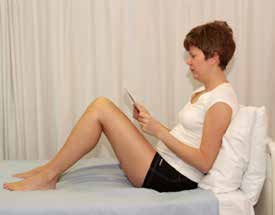
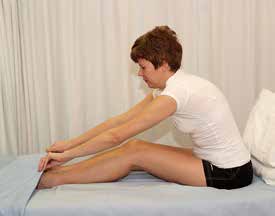
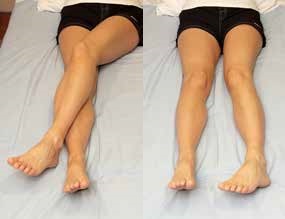
Do:
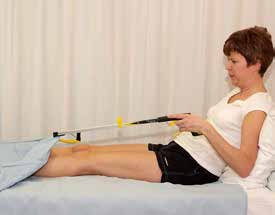
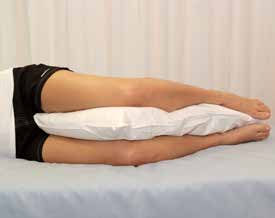
Getting out of bed
Do not:
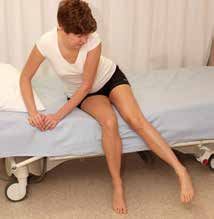
Do:
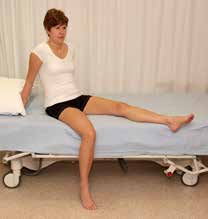
In sitting
Do not:
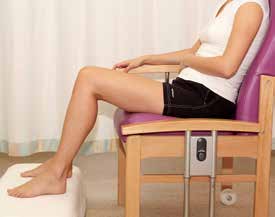
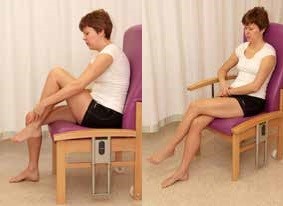
Do:
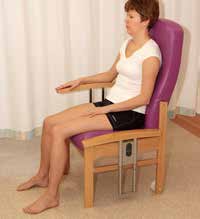
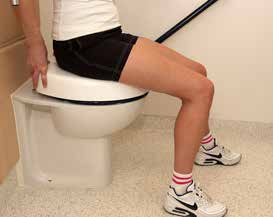
In standing
Do not:
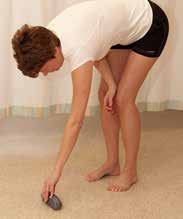
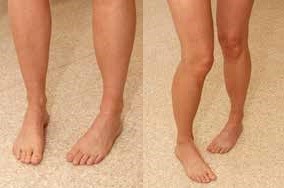
Do:
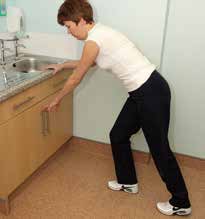
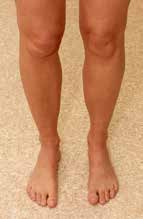
Getting into a car
Do not:
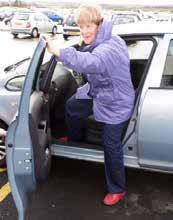
Do:
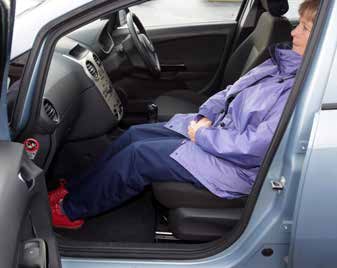
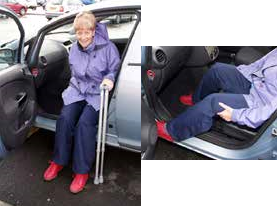
Remember: Even if you have no pain, and you feel as though you can move normally, you must follow these precautions for eight weeks after your operation to prevent your new joint dislocating.
Physiotherapy following your hip replacement
Physiotherapy is crucial to your rehabilitation following your operation. In order to get the best physical results from your joint replacement, it is extremely important that you follow the instructions and advice given by the physiotherapy staff. Common terms used in physiotherapy:
- Flexion: bending action of the hip
- Abduction: moving whole leg out to the side
- Extension: moving leg back behind you
- Quads: large muscles at front of thigh to straighten the knee
Exercises
You will be taught a series of exercises to increase the movement of your joint and to strengthen the muscles around the hip. They will also help reduce swelling and pain. It is advisable that you take enough pain relief to allow you to perform your exercises.
You can find videos of these exercises further down this page. You should practice these three to four times every day, increasing the number of repetitions as indicated by your physiotherapist.
You must take responsibility for your own exercises out with physiotherapy sessions.
When performing any exercise, maintain a comfortable posture and keep your breathing regular.
It is expected that you will need to carry out all the exercises described below. However, there may be an occasion when you might have to omit a particular exercise: your physiotherapist will advise when and why this is appropriate.
Moving around
It is important to become mobile quickly following your operation. This will help prevent circulation complications as well as being good for your whole body in general. You may be out of your bed a few hours post surgery. Initially you may need a walking frame or elbow crutches to help you walk.
There may be a restriction on the amount of weight you can put on your operated leg. Your physiotherapist will advise on this.
Standing up safely when using a walking frame
- Move to the edge of the bed or chair.
- Keeping feet hip width apart, bring them back as far as is comfortable. Your operated leg may not comfortably bend as far as your other leg.
- Place your hands on the bed beside your hips or on the arms of the chair.
- Lean forwards, push down on your hands and stand up.
- Now take hold of your walking frame and stand up straight.
Standing up safely when using walking sticks or elbow crutches
- Move to the edge of the bed or chair.
- Keeping feet hip width apart, bring them back as far as is comfortable. Your operated leg may not comfortably bend as far as your other leg.
- Place your sticks or crutches in the hand on the same side as your operated hip.
- Place your other hand beside your hip or on the arm of the chair.
- Lean forwards, push down on your hands and stand up.
- Take a crutch or stick into each hand: your physiotherapist will further explain how to do this.
Sitting down
- Prior to sitting, ensure you can feel the bed or chair behind your legs.
- If using a walking frame, reach down and back with your hands to feel for the bed or chair.
- If using crutches or sticks, take them across to the hand on your operated side and reach down and back with your other hand to feel for the bed or chair.
- Bend your knees, stick your bottom out and ease gently down to sit.
Walking
It is essential you achieve a normal walking pattern and your physiotherapist will work with you to achieve this.
The technique is to place your walking aid forward, step forwards with your operated leg, bringing your bottom forwards over your knee, lean through your hands onto your walking aid, then step through with your other leg. When walking with sticks, you should use them with the handle facing backwards. When you have progressed to one stick, hold it in the hand opposite the operated leg. Walk placing the stick on the ground at the same time as the operated leg.
Before you go home, the physiotherapist will advise you when to start using only one stick or crutch and progress to walking with no aids.
Stairs
You will be shown how to go up and down stairs safely and how to protect your hip when doing so. Stairs practice is necessary for everyone – even though you may not have stairs at home, you will have to negotiate kerbs or stairs out with your own home.
Going up stairs:
- Use handrail if available.
- Step up with unoperated leg.
- Follow with operated leg onto same step.
- Bring up the crutch or stick onto the same step.
Going down stairs:
- Use handrail if available.
- Place crutch or stick down onto step.
- Step down with operated leg onto same step.
- Follow with unoperated leg onto same step.
Continuing physiotherapy at home
You must continue with your exercises at home every day, two to three times a day. Gradually increase your walking distance with your sticks or crutches.
Remember: even if you have no pain, and you feel as though you can move normally, you must follow the precautions for eight weeks after your operation to prevent your new joint dislocating.
There is no routine follow-up with outpatient physiotherapy services unless the consultant requests this after your 6-8 week follow-up. Many of those who undergo a hip replacement do not require any follow up with physiotherapy.
Occupational therapy following your hip replacement
Dressing
When dressing, sit comfortably with feet on the floor; both feet pointing forward. You should dress operated leg first and undress it last. Always use the dressing equipment provided. If you have this equipment at home, please bring it into the hospital with you. If you need to wear TED stockings after surgery, please arrange for someone to help you with this as you won’t be able to put these on yourself.
Bathing
If you have a shower cubicle, you will be able to step into the cubicle and stand in the shower. An anti-slip mat is useful. If you have a shower over your bath, you should not step over the side of the bath for eight weeks after your surgery. If your bath is suitable, we will give you a shower board, so that you do not have to step over the side of the bath. If you have a bath only, you will need to ‘wash down’. If this is not acceptable, please speak to your occupational therapist. It is important that you do not attempt to sit down in the bath until at least 12 weeks after surgery.
Kitchen
OT staff will ask you how much work you will need to do in the kitchen. If you live alone (or on your own at home during the day) it is helpful to have a seat at your kitchen worktop so you can sit to prepare a light meal. It is a good idea to stock up on frozen meals, even for the first week or two, until you are more confident on your feet. Also, move any items you regularly use to a position where you can reach them easily. OT staff will demonstrate the correct technique for getting items from a low height – for example the washing machine.
Driving
You should not drive for at least eight weeks after hip surgery. Your consultant or family doctor (GP) will advise you further.
Remember: In an emergency, you will need to be able to hit the brake fast, with precision and without any hesitation.
If you travel by car you should sit in the front passenger seat.
Before getting into the car, your driver should:
- Ensure that the seat is as far back as it can go.
- Ensure that the backrest is slightly reclined.
- Try to have the car positioned away from the kerb so that you are getting into the car from road level.
- Put a plastic bag/sheet on the seat to help you slide in and out more easily.
Toilet
Getting on or off a toilet is similar to a chair. If your toilet is too low, you will be given a raised toilet seat.
OT staff will see you after you have had your new hip and go over the precautions to follow. Please don’t hesitate to ask a staff member if you have any concerns about any activities you need to do on discharge or anything you are concerned about.
If you have been given the loan of a long-handled shoehorn, easireach or clip-on raised toilet seat, these should be returned to the OT Department, University Hospital Crosshouse eight weeks after you have had your new hip.
Any other equipment should be returned to your local Community OT Department. Please contact the following departments to arrange pick-up of your equipment or you can arrange to drop off the equipment to them.
East Ayrshire Community OT Store
3 Southook Road
Kilmarnock
Telephone: 01563 527825
North Ayrshire Community OT Store
Unit 34, Kyle Road
Irvine
Telephone: 01294 313891
South Ayrshire: Community OT Store
12 Dukes Road
Troon
Telephone: 01292 319635
Discharge
You will be able to go home from hospital when you and the team looking after you think it is safe to do so.
Before you go home, we will give you advice on any new tablets, such as painkillers and when to start any tablets that were stopped. If the district nurse is going to visit you, you will have a letter confirming that.
Your medication will be returned to you however, you may be required to contact your family doctor (GP) for a ‘top-up’ of medication.
Helpful hints on discharge
Do:
- Continue with your exercises as you have been instructed – little and often. Click HERE to access these exercises
- Go for short walks regularly. Use your walking aids to assist.
- Keep using your raised toilet seat for at least six weeks
- Sleep on your back with a pillow between your legs (this is very important for six to eight weeks if you have had a hip replacement). If you have had a dynamic hip screw (DHS) or other such surgery this is not necessary, but you will probably still find this the most comfortable position.
Don’t:
- Twist the operated leg
- Sit on anything that is too low or furniture that is too soft
- Cross your legs if you have had hip replacement surgery
- Bend down to tie shoelaces or pick up objects from the floor if you have had hip replacement surgery
Normally the exercises you have been shown are sufficient to enable you to return to your normal level of mobility, providing you continue them as home. If you have any worries or concerns regarding your recent surgery, you can contact your family doctor (GP) for advice.
Is my wound healing properly?
Your wound will be checked regularly while you are in hospital to make sure that it is healing properly. If the wound is dry/not leaking excessively, the dressing may be left undisturbed, but it will be changed before you are discharged.
It is normal for your wound to be bruised and sore at first. This will settle down as the healing process begins.
Stitches/clips will be taken out 10 to 14 days after your operation. The practice nurse at your GP surgery will inform you of when this will occur. Some wounds have special stitches that do not need to be removed but the district nurse will still visit you to check your wound.
If your wound becomes painful, hot, red or develops a discharge while at home, contact the Advanced Nurse Practitioner.
It is quite normal to have some swelling in your leg after the operation. To get rid of this you should:
- Avoid prolonged standing.
- When sitting on a chair, sit with your legs elevated on a stool and do regular ankle exercises (keeping a gap between your legs if you have had hip replacement surgery).
What happens if I have a problem when I get home?
When you are discharged from hospital, you will get an outpatient appointment to see your orthopaedic surgeon. Any orthopaedic problems can be sorted out at this time. If you feel that you need to be seen before the appointment date, your own family doctor an arrange one sooner.
If you need advice about anything, contact the ward you were in.
An Advanced Nurse Practitioner can be contacted for advice.
The future
Progression from two walking sticks to one
Keep using two walking sticks for at least six weeks after surgery. After this time, you can try to progress to one stick.
The stick should be held on the opposite side from the operated leg, for example if your right hip was operated on you should hold your stick in your left hand.
If this causes you to limp, you have tried to progress too early. You should return to two sticks, continue with the hip strengthening exercises and try again in a few days.
See the exercises further down this page.
Exercise advice
Remember the muscles around your operated hip have been weakening since your hip first became painful. Do not stop your strengthening exercises too soon.
Walking should not be used as an alternative to specific hip exercises in the early stages.
Instead, exercise regularly and walk well as a result.
At 8 to 10 weeks, or at your surgeon’s discretion, you may:
- Drive a car – depending on which leg is involved.
- Attempt sexual intercourse (with care).
- Try general household activities, spreading chores evenly and again avoiding prolonged standing.
- Start your hobbies again – only activities with no or low impact are recommended, for example gardening, dancing, walking, cycling, bowling and swimming – all very gently and without excessive effort.
- Golf should be delayed until around 18 weeks after surgery. It is recommended that you limit your back swing and avoid excessively hard swings and severe rotatory motions.
- Avoid bending and prolonged standing in the first 3 months. Digging during this period is not advisable.
- High impact activities such as running are not recommended.
With all these activities, timing may vary from surgeon to surgeon, so it is important to check with your doctor and physiotherapist/occupational therapist/nurse before you start them.
Remember this information is only intended as a guide and a reminder for you and your family.
Hip joint replacement exercises
The exercises in the videos below have been provided to help with your hip pain as you recover from your surgery. If there is any doubt about your fitness to do these exercises then please discuss this with your GP or consultant.
You may find that these exercises may slightly increase your symptoms initially. However you should find that the exercises themselves will become easier to do and that you begin to move your knee more easily. It can take around 12 weeks for you to notice a great improvement.
If the exercises do cause some discomfort, then taking prescribed medication from your GP or pharmacist may help you to continue to exercise.
If these exercises cause a large increase in your pain, or after 12 weeks there are no noticeable changes in your day to day symptoms, please contact your GP or NHS Inform for more advice.
The guide below will help ensure you are working at the right level.
Pain during exercise

Within the scale, aim to stay in the green or amber boxes. If you are in the red area then you can modify the exercises by:
- reducing the amount of movement during an exercise
- reducing the number of repetitions
- reducing the weights
- reducing your speed
- increasing rest time between sets
Pain after exercise
Your pain or other symptoms should return to your pre-exercise baseline within 30 minutes of exercising. On the morning after your exercises, you should not feel an increase in pain or stiffness that lasts longer than 60 minutes.
Disclaimer
Please note: These exercises should not be used without prior consultation with a medical professional as the use of the wrong exercise may cause additional health related issues and discomfort. NHS Ayrshire & Arran and MSK NHS Ayrshire & Arran are not liable or responsible for any harm, losses or damages whatsoever resulting from the use or misuse of the information contained in or implied by the provided information in each video. These are provided for information only.
If you have any concerns about your ability to perform exercise then please discuss your concerns with your doctor or healthcare provider prior to participating in any advice that is on the MSK NHS Ayrshire & Arran website.
Please choose the most relevant exercise section for you.
Section 1: Mobility Exercises
After Total Hip Replacement surgery, it is important to improve range of movement at your hip once discharged home. You still need to be aware of the precautions to prevent dislocation as advised by your consultant and physiotherapist.
The below exercises are to improve the range of movement at your operated hip. This can be uncomfortable to start with as your hip may have had reduced movement prior to your hip replacement surgery.
Regular mobility exercises are important in your rehabilitation post-operatively to improve the movement at your new hip and it is recommended to do 3 sets of these exercises daily.
Exercise 1 – Hip Flexion and Knee Flexion in Lying
To do this exercise – Lie in bed with your operated leg lying straight in front of you. Using your heel on the bed to assist if needed, then slide your heel upwards towards you to bend your knee and hip, then return to starting position. Repeat for 10-15 repetitions.
Do not bend your hip more than 90 degrees. It’s important to keep heel on the bed to assist with this if needed initially.
Repeat this 3 times per day.
Exercise 2 – Hip Abduction
To do this exercise – Start in either sitting or lying in bed with both legs straight out in front. Gently slide the operated leg out to the side keeping your foot and knee pointing upwards. Then slide your leg back in towards the middle. Try and make sure you do not pass the midline.
To help get further movement use your hand on your thigh to assist the outwards movement and then push further outwards with your hand. Then return the operated leg in to middle. Aim for 10 repetitions initially increasing to 20 repetitions as able.
Repeat 3 times per day.
Section 2: Strengthening Exercises
An important component of your recovery after your hip srurgery is to strengthen your muscles around the hip joint. This will help regain your function and help improve your mobility. At first you may find some of the exercises below uncomfortable however as you become stronger and fitter you will feel the exercises becoming easier.
Exercise 1 – Static Quadricep Contraction
To do this exercise – Start in either sitting or lying with your operated leg out straight in front of you. Tense your thigh muscle by pushing the back of your knee down into the bed. Hold exercise for 5 seconds, then relax. Repeat for 15 repetitions.
Repeat 3 times per day.
Exercise 2 – Inner Range Quadriceps Contraction
To do this exercise – Sit or lie in bed with a rolled-up towel under your knee. Straighten your leg keeping the back of your knee on the towel. You should feel the front of your thigh muscles working as you hold your knee straight for 5 seconds. Then return to starting position. Repeat 10 repetitions.
Repeat 3 times per day.
Exercise 3 – Bridge
This exercise is to strengthen the muscles in your bottom.
To do this exercise – lie on your bed with your knees bent and feet flat on the bed with your hand resting by your side. Start by tilting to your pelvis so you flatten your lower back on to the bed. Push through your heels to lift your buttocks and lower back upwards off the bed. Then slowly lower back down. Initially aim for 10 repetitions of this exercise.
As you become fitter and stronger aim to hold this exercise for 5 seconds before lowering back down to starting position.
Repeat 3 times per day.
Exercise 4 – Mini Squats
To do this exercise – Stand holding the back of the chair for support. Slowly bend both knees and bring bottom back as if doing a half sit down. Then return to standing position. Aim initially for 10 repetitions as comfort allows.
To help with this keep the weight on your heels as you bend your knees down.
Over time you will find this easier and you will gradually increase your repetitions to 15, 3 times daily.
Exercise 5 – Standing Hip Abduction
This next exercise is to strengthen the muscles at the side of your bottom.
To do this exercise – Stand holding the back of the chair for support facing forwards. Lift your operated leg slowly out to the side as much as able then slowly bring the operated leg back towards the middle. Aim for 10 repetitions. Repeat this 3 times per day
As you become stronger aim for 15 repetitions, 3 times per day.
To make this exercise easier step out with your operated leg to the side, tapping foot down, then return into the middle. It is important to stay upright to help your balance and to not compensate with the opposite side.
Exercise 6 – Standing Hip Extension
This exercise is to strengthen the muscles in your bottom.
To do this exercise – Stand holding onto the back of a chair, or worktop for support. Bring the leg of your operated side backwards as far as comfortable maintaining an upright standing position. Then return to starting position. Aim for 10 repetitions. Repeat this 3 times per day.
To make it easier step back with operated leg tapping foot down before returning back into the starting position. To progress this exercise step back with the operated leg. Hold for 5 seconds before returning to starting position. Aim for 10 repetitions. Repeat this 3 times per day.
Exercise 7 – Standing Hip Flexion
This exercise is to strengthen the muscles at the front of your hip.
To do this exercise - Stand at back of chair for support. Standing upright lift operated leg up so your thigh is parallel to the floor if able. Then relax leg down to starting position. Aim for 10 repetitions initially. Repeat this 3 times per day.
Do not bend hip more than 90 degrees if advised by consultant as a precaution after your surgery.
Exercise 8 – Sit to Stand
To do this exercise – Start by sitting on a higher chair with arm supports. Move to the front of the chair. Initially use your arms to help you stand up. On going to sit down move your feet back so the back of your legs feel the chair behind. Then slowly bend your knees and sit down. Aim for 10 repetitions. Repeat this 3 times per day.
Once you find this easier try this exercise without your hands. As time progresses try have equal weight through both legs during this exercise. Building up to 3 sets of 10 repetitions daily.